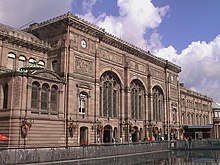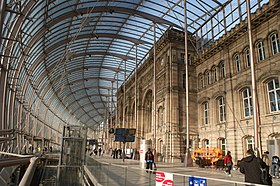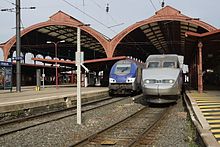Strasbourg-Ville train station
| Strasbourg-Ville | |
|---|---|
|
The forecourt of the Strasbourg train station lies behind and under a curved glass wall
|
|
| Data | |
| Location in the network | Junction station |
| Design | Through station |
| Platform tracks | 14th |
| abbreviation | XFSTG |
| IBNR | 8700023 |
| opening | 1883 |
| Profile on SNCF.fr | Code: fraeg |
| Architectural data | |
| architect | (1883) Johann Eduard Jacobsthal (1900) Hermann Eggert (2007) Jean-Marie Duthilleul |
| location | |
| City / municipality | Strasbourg |
| Department | Bas-Rhin department |
| region | Grand Est |
| Country | France |
| Coordinates | 48 ° 35 '6 " N , 7 ° 44' 4" E |
| Height ( SO ) | 143 m |
| Railway lines | |
|
|
| List of train stations in France | |
The Strasbourg-Ville train station ( French Gare de Strasbourg-Ville , German also often called "Strasbourg Central Station ") is the central train station in the Alsatian capital of Strasbourg . It is specially protected as a monument (French Monument historique ). With 20 million travelers a year, it is one of the most important train stations in France.
history
Today's Strasbourg train station is the city’s second train station. The first station, inaugurated on September 15, 1854, was a terminus station and was located at today's place des halles . It was partially destroyed in the Franco-German War in 1870/71 and rebuilt under German administration from a military point of view. It was demolished in 1974 and is now a shopping center on the site .
The construction of today's station goes back to the construction activities of the German Empire . The station was built on the site of the Strasbourg Vauban fortifications. Construction work began in 1878 based on a design by the Berlin architect Johann Eduard Jacobsthal . The station was inaugurated on August 15, 1883 and replaced the old Strasbourg terminus. However, the construction work was not finally completed until 1898. The station originally served not only as a passenger , but also as a freight and shunting yard .
Between 1901 and 1906, a post office and a police building were added on either side of the reception building. The marshalling yard was moved to the outskirts of Strasbourg in 1906 (Hausbergen station, closed in 2006). The freight yard followed in the years 1912 to 1914. Three new platform tracks were added by 1936.
Reception building

The reception building has two floors, is 128 meters long and is made of red sandstone from the Vosges . The ground floor is at the level of the station forecourt . Stairs lead from there to the platforms. The tracks are spanned by two steel arches. The facade is designed in neo-renaissance . It was the first large public building in Strasbourg that the new German rulers erected after the Franco-Prussian War of 1870/71 and should be large enough to handle a whole German army. From the beginning it was electrically lit and provided with central heating . Freight elevators originally carried luggage to the platform.
Until the return of Strasbourg to France in 1918, the building was adorned with the frescoes of two German rulers: one showed the entry of Friedrich Barbarossa into Hagenau in 1164, the other depicted Emperor Wilhelm I in Strasbourg in 1877. Both were supposed to confirm that Alsace-Lorraine belonged to the German Empire symbolize. A special feature are the rooms for the German imperial family in the train station that still exist today. A richly decorated salon was set up for the emperor and the empress, which they never used and which today accommodates guests of honor. The architect of these imperial rooms, which were added around 1900, was Hermann Eggert , who had already designed the Strasbourg Imperial Palace . The reception building with its rich decoration has changed little since it was completed at the end of the 19th century until the beginning of the 21st century . However, the two frescoes by Hermann Knackfuß , with which he had decorated the side walls of the large reception hall in 1885, disappeared irretrievably in the course of the 20th century . The murals “In the old realm” (arrival of Friedrich I. 1164 in Haguenau ) and “in the new realm” (visit of the fortress Crown Prince in Hausbergen, today Fort Foch , Niederhausbergen , by Wilhelm I on May 3rd, 1877) were due to their undisguised Nationalism and imperialism after 1918 were no longer acceptable.
The facade is decorated with two reliefs and the main hall with two allegorical statues of women ("Agriculture" and "Industry"), all of which are made with Otto Geyer's chisel and were attached in 1882.
Great reception hall (2013)
Modifications in 2006/2007
In the course of the connection to the TGV traffic, the station underwent major renovations in 2006 and 2007. With a glass wall placed in front of the reception building, which is arched at the top and connects to the facade of the building, a new anteroom was created, under which an additional basement was created. The old station building and the new entrance hall received a Multibeton - underfloor heating . A new computer-controlled signal box , the largest in France, was installed on November 4th and 5th, 2006, which resulted in a 30-hour interruption in rail operations. 300 workers worked daily on the station renovation, which resulted in total costs of 150 million euros. In addition to the railway facilities, the station forecourt was redesigned and a bicycle parking space for 850 bikes was set up. The redesigned station was inaugurated on November 5, 2007 with a four-month delay.
business

The Strasbourg train station is one of the most important train stations in the east of France and is owned by the French national railway company SNCF . In addition to SNCF, German railway companies such as Deutsche Bahn and SWEG also regularly visit the station. Since the LGV Est européenne went into operation on June 10, 2007, both long-distance and local traffic have improved considerably. Since then, TGVs have been arriving at Strasbourg station for the first time . Since 2011, with the commissioning of the LGV Rhin-Rhône , the connections to the south have also improved significantly. In 2018, over 20.1 million travelers used the station. Strasbourg train station used to have a loading bay for motorail trains .
Long-distance transport
Two important long-distance routes meet in Strasbourg. On the one hand, Strasbourg is a stop on the main line for Europe , which connects Paris via Strasbourg with Karlsruhe , Stuttgart , Munich and Vienna as well as with Bratislava and Budapest . In addition to this east-west axis, Strasbourg is also on the north-south axis from Brussels via Luxembourg , Strasbourg to Mulhouse, on to Switzerland, and from Mulhouse to Nice on the Mediterranean . Since April 9, 2013, the pair of trains EuroNight EN 452/453 Paris– Moscow (via Berlin , Warsaw and Minsk ) has been running via the Strasbourg station.
Since the high-speed line to Paris went into operation , TGV trains have been running every hour to Paris Est , with a total of four pairs of trains going to Stuttgart Hbf , including one to Munich Hbf . The EuroNight train to Vienna Westbahnhof , known as the Orient Express , was discontinued for the 2009/2010 timetable change in December 2009. Since the opening of the LGV Rhin-Rhône high-speed line in 2011, there have also been six daily TGV connections from Strasbourg to Lyon and, in some cases, to Marseille or Montpellier . There are also several French express trains that connect the Côte d'Azur with Strasbourg. Depending on a euro or Intercity -Zugpaar make direct connections with Brussels ago. In addition, a pair of trains run daily between Frankfurt Hbf and Marseille and several pairs of trains on the Frankfurt - Paris Est line via Strasbourg.
Local transport
In Switzerland there are also long-distance trains to Basel SBB station , but mostly local services run every half hour to the SNCF station . The Europabahn connects Strasbourg every half hour at rush hour with Offenburg in Germany (via Kehl and Appenweier ). There are also numerous TER connections within Alsace, to Strasbourg airport and to Saarbrücken in Germany (via Sarreguemines ).
tram
The tram lines A and D, which run in the tunnel 17 meters below the train station, connect the train station with various destinations in the city and its surroundings. Above ground, line C has ended on the station forecourt since late 2010 .
Northern track apron with parked TER push-pull train
Regional railcars and a German ICE (right)
Railcar of Ortenau-S-Bahn at the station Strasbourg
Rail tracks, and hall of the passenger station from the south
Southern driving out and depot with roundhouse
literature
- La France des gares , Gallimard collection, 2001, pp. 168-169.
- Welcome to Alsace: Gare de Strasbourg-Ville. In: Dein Bahnhof - magazine of German shopping stations , autumn 2017, pp. 32–34
Web links
- Strasbourg train station before the renovation. In: Structurae
- Strasbourg station during and after the renovation. In: Structurae
- Practical information about Strasbourg train station (French)
- History of the station and current construction work (website of the City of Strasbourg) ( Memento from October 19, 2007 in the Internet Archive ) (French; PDF; 15.6 MB)
- Virtual tour on gares360.com
Individual evidence
- ↑ Ancienne gare de Strasbourg - 1 rue de Sébastopol - Architecture et photos à Strasbourg. Retrieved May 25, 2015 .
- ↑ Gare de Strasbourg on archi-strasbourg.org
- ^ The frescos by Hermann Knackfuß on archi-strasbourg.org (French)
- ↑ Multibeton: Bahnhof in Strasbourg ( Memento of the original dated February 11, 2017 in the Internet Archive ) Info: The archive link was inserted automatically and has not yet been checked. Please check the original and archive link according to the instructions and then remove this notice. Troisdorf, 2014
- ↑ http://www.territorial.fr/PAR_TPL_IDENTIFIANT/3137/TPL_CODE/TPL_HYPERBREVE_FICHE/PROV/RSSALAUNE_SIT_TERRITORIAL/803-actualite.htm Message from territoiral.fr accessed on December 25, 2007
- ↑ Fréquentation en gares - Strasbourg on SNCF Open Data (French)
- ^ Strasbourg-Moscou en train, c'est désormais possible , France 3 Alsace, April 10, 2013














